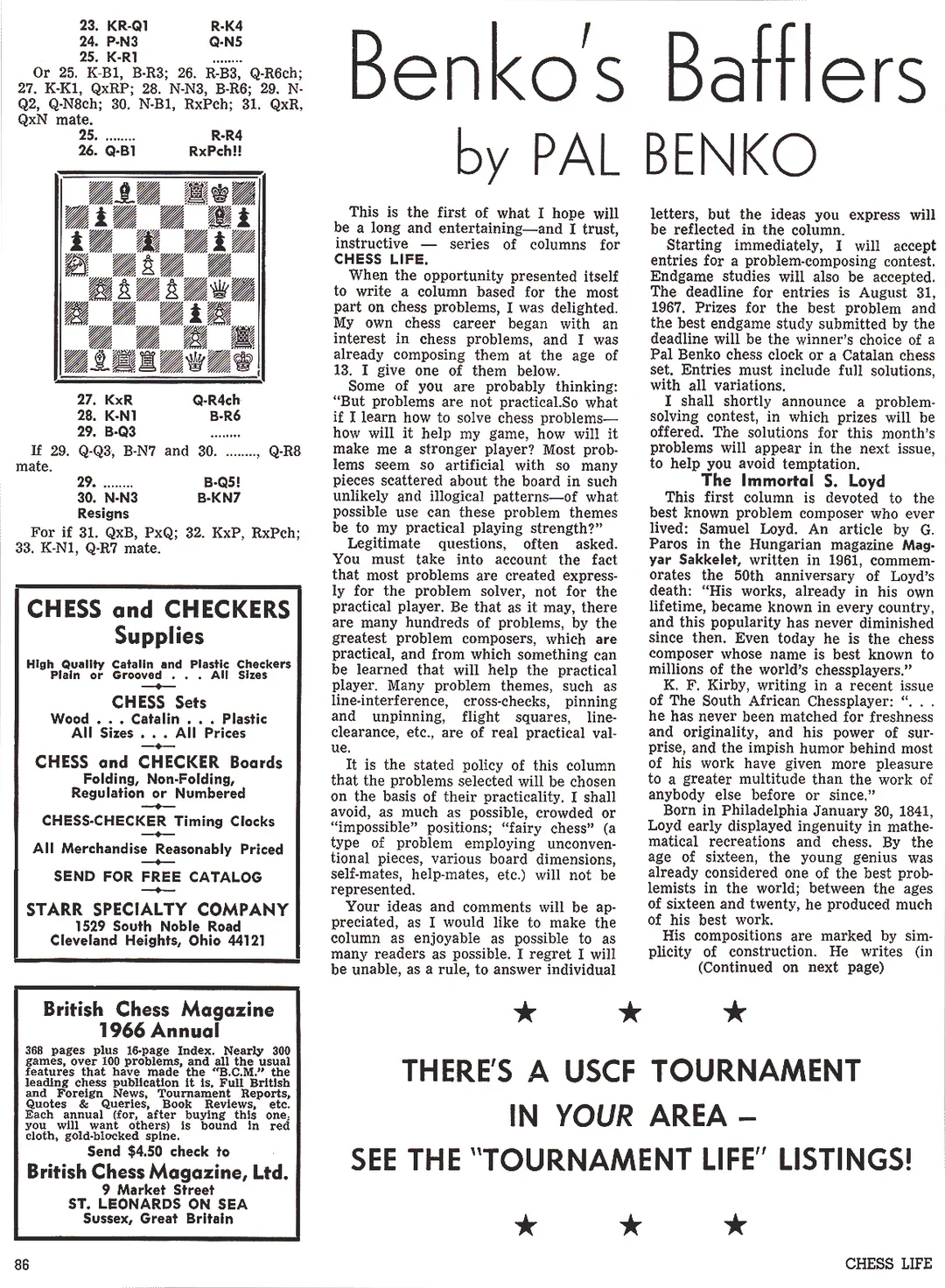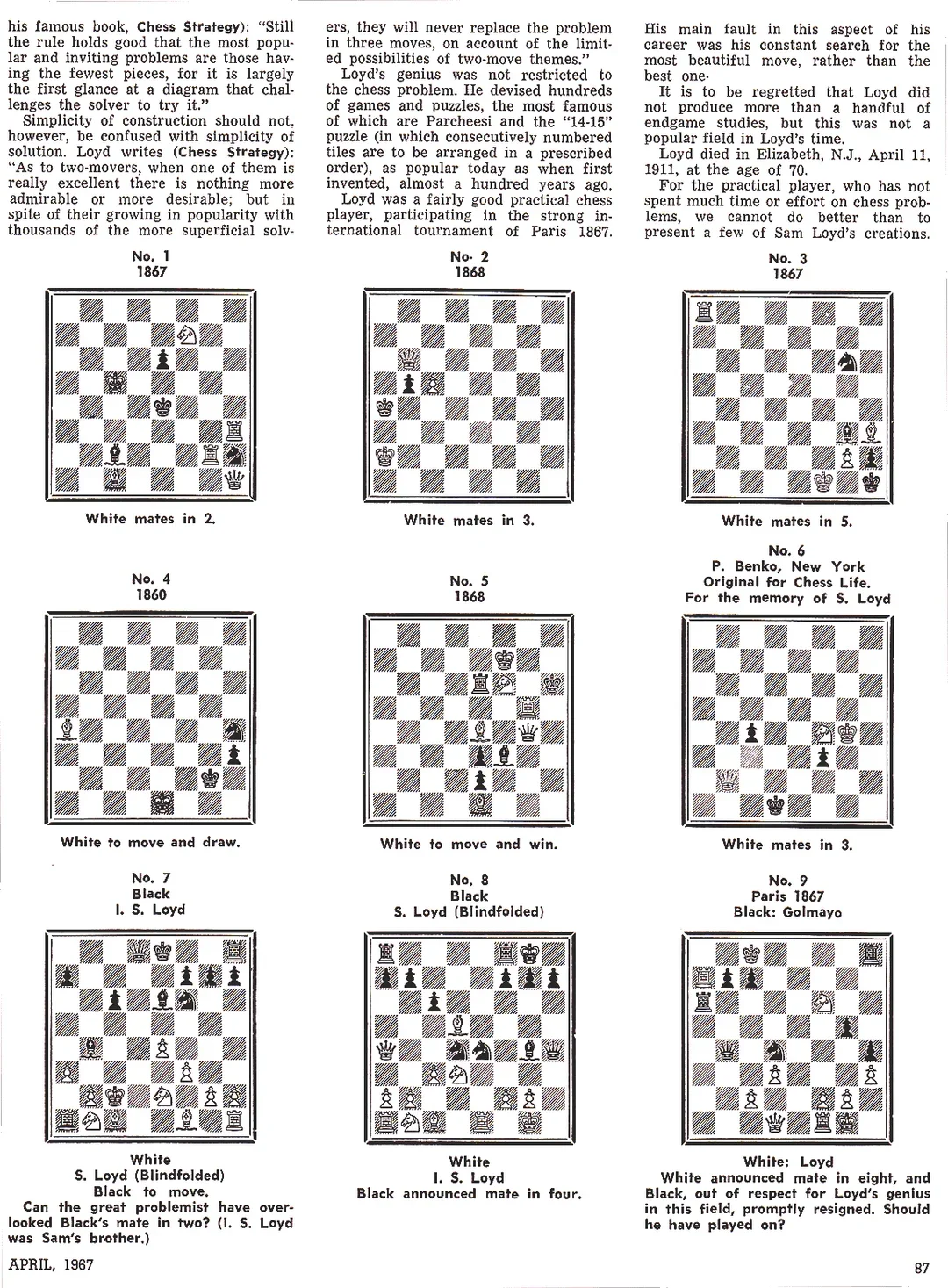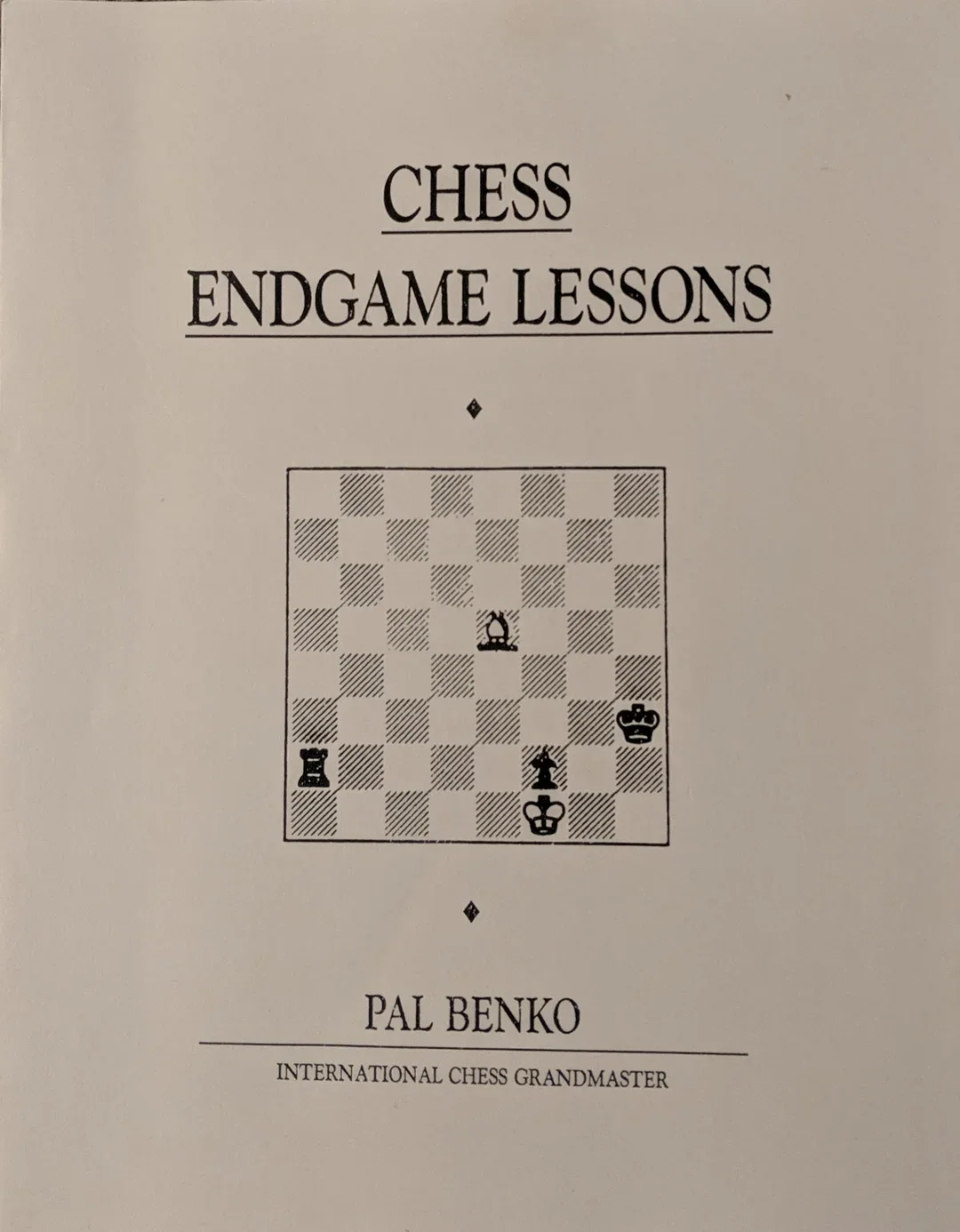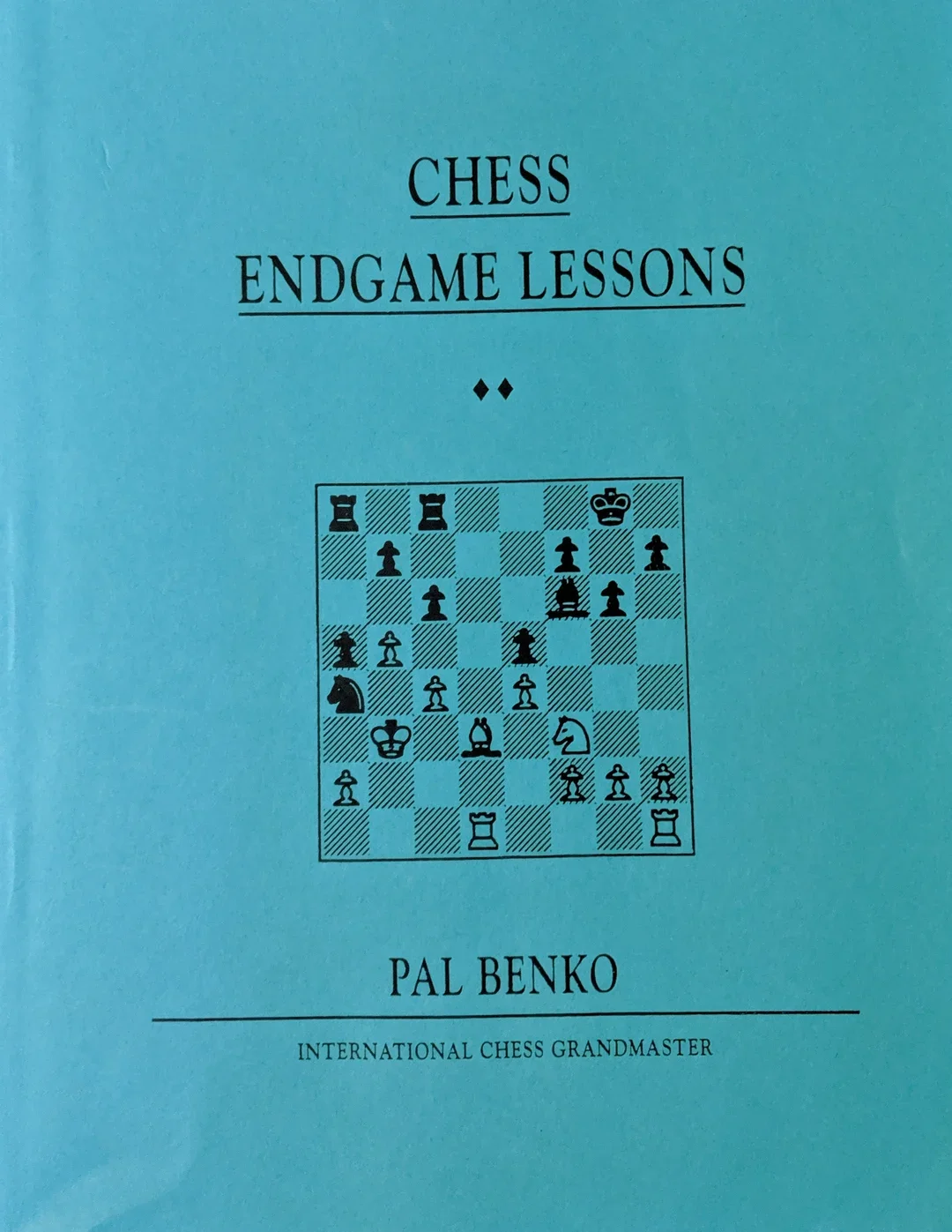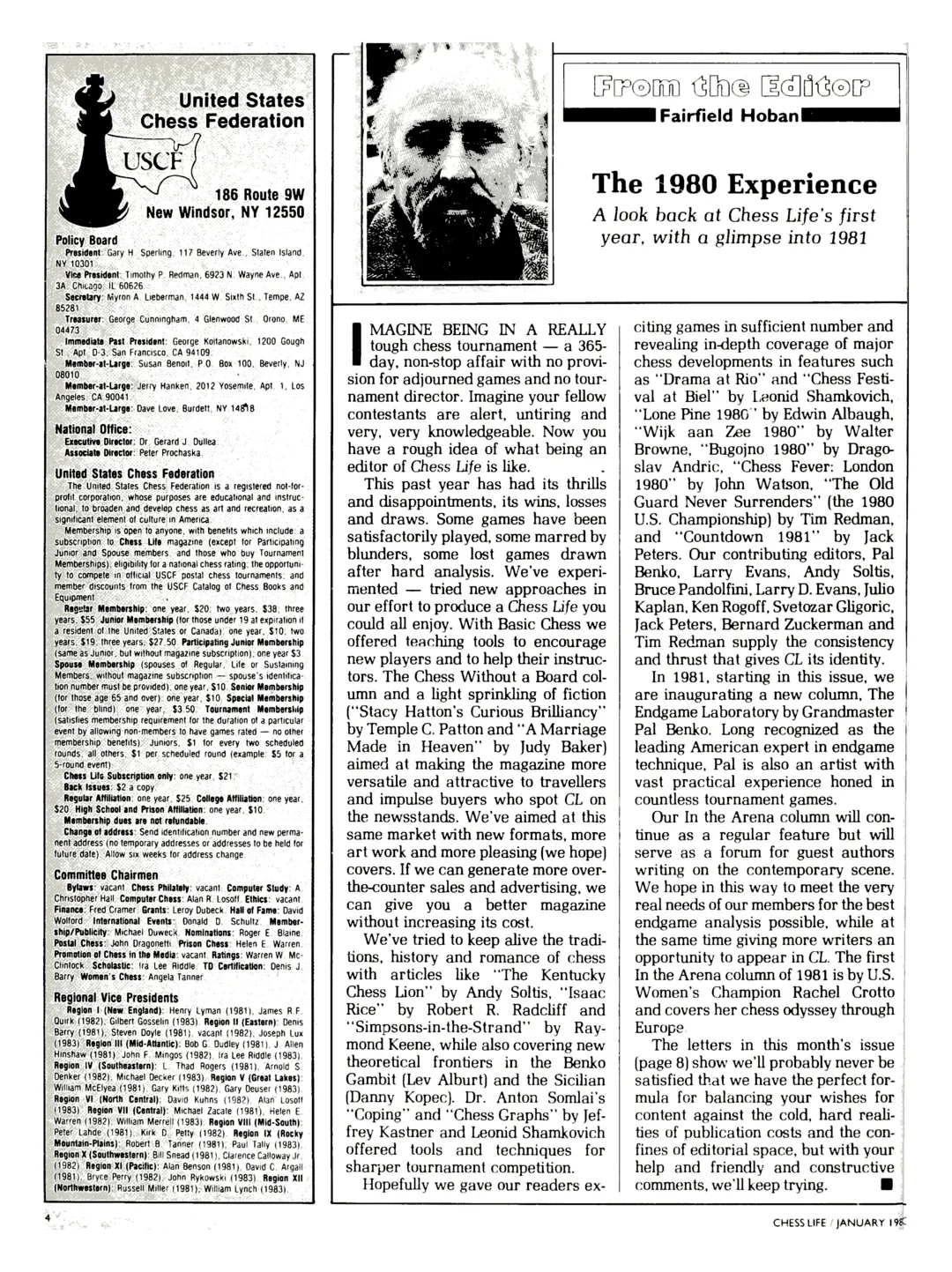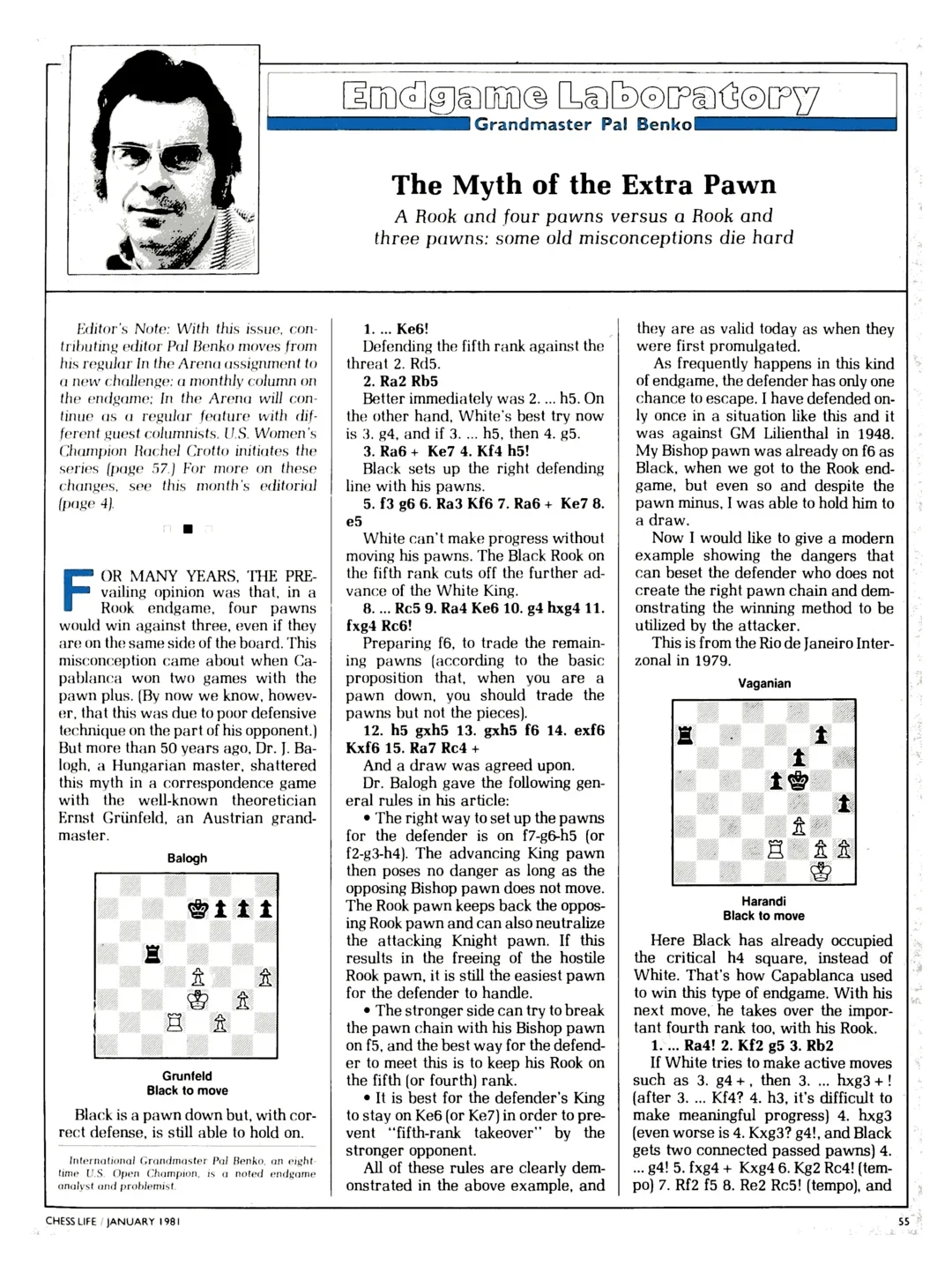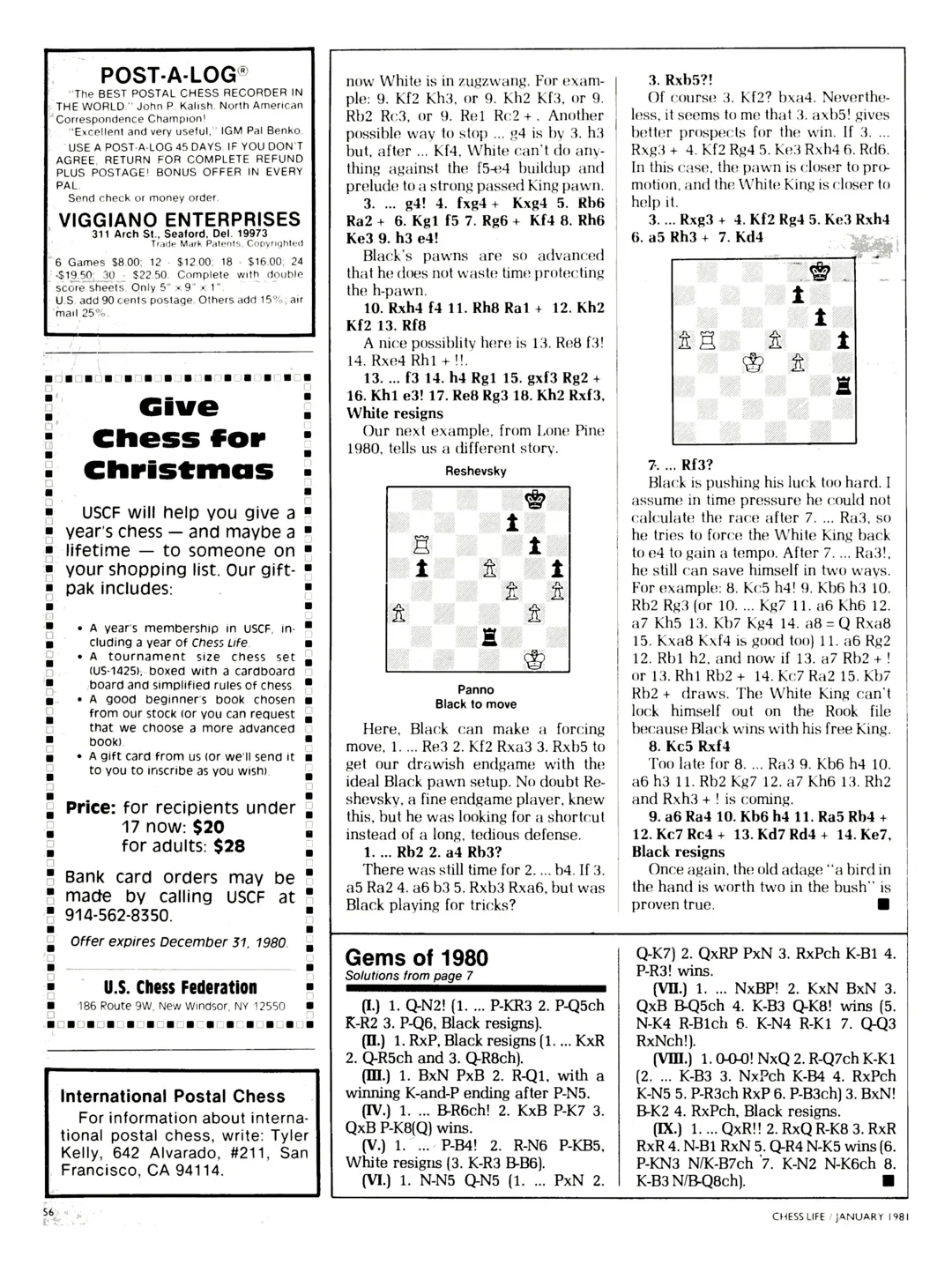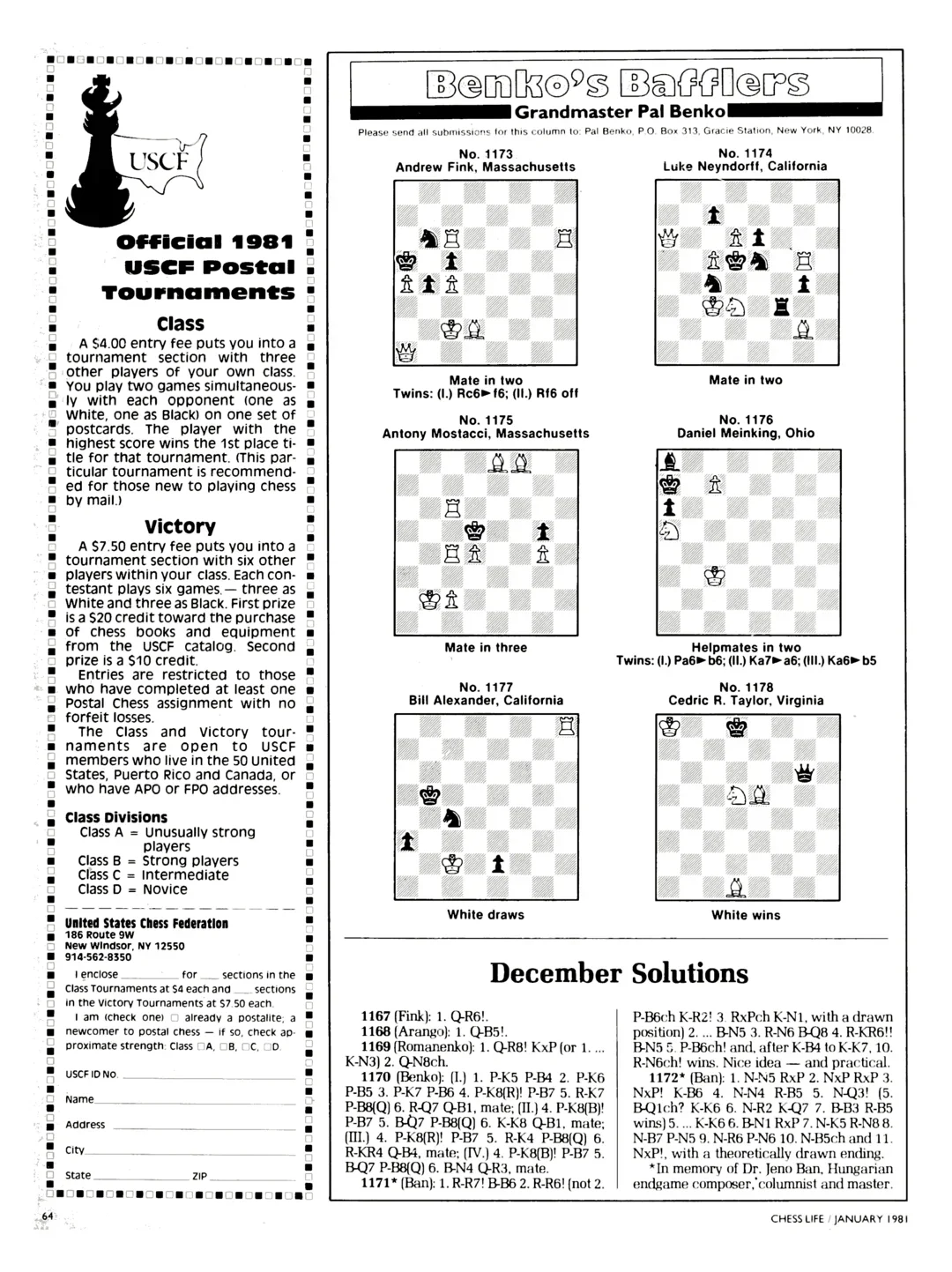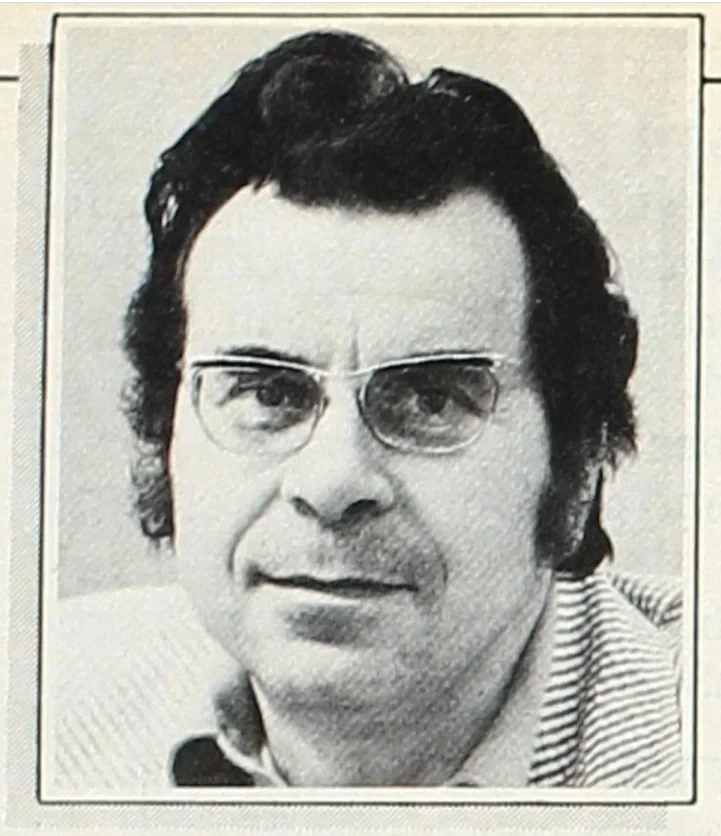With the death last week of GM Pal Benko at age 91, it seems appropriate on this Thursday to take a look back his 46 years writing for Chess Life.
Long known as a leading authority on problems and studies, Benko’s first and longest-running contribution to Chess Life was “Benko’s Bafflers,” a monthly set of composed problems (usually studies) for readers to solve. Answers were initially provided two months later, i.e., a January issue would have answers from the previous November. Later they were printed in the back matter of the same issue.
Benko's first column from April 1967 is also available in pdf format: page 1 | page 2
“Benko’s Bafflers” ran from April 1967 through December 2013, when Benko chose to retire from his column. At the time of his retirement Benko was also writing his legendary “Endgame Laboratory,” which focused on the endgame in all of its facets. Benko collected twenty years of his columns in the two volumes of his Chess Endgame Lessons (1989, 1999), both of which remain highly sought after by chess book collectors.
Benko’s “Endgame Lab” was published from January 1981 through December 2013. In his first column, shown here, Benko focused on a very common type of endgame – rook endings with four pawns for one side, and three for the other, with all the pawns on the same side of the board.
You can also read this inaugural column in pdf format.
Here are the games from the column in replayable format. Note that there is a correction to the Harandi-Vaganian game as it is presented in MegaBase. Benko’s version, with 44. … Ra4, is correct, as confirmed through reference to both the English and Russian language tournament books.
[pgn]
[Event "IFSB EU-OL prel-B bd1"]
[Site "corr"]
[Date "1935.??.??"]
[Round "?"]
[White "Gruenfeld, Ernst (GM)"]
[Black "Balogh, Janos"]
[Result "1/2-1/2"]
[ECO "D08"]
[SetUp "1"]
[FEN "8/4kppp/8/2r5/4P3/4K1PP/3R1P2/8 w - - 0 40"]
[PlyCount "30"]
[EventDate "1935.??.??"]
[EventType "team (corr)"]
40. h4 ({The Megabase annotator gives} 40. Rd5 $1 {as it prevents ...h5,
at least initially. But Black can still draw this with} Rc3+ 41. Ke2 (41. Rd3
Rc2 42. h4 h5) 41... g6 42. Rd3 Rc4 43. Ke3 h5 {reaching the desired setup.})
40... Ke6 $1 41. Ra2 Rb5 42. Ra6+ Ke7 43. Kf4 h5 $1 44. f3 g6 45. Ra3 Kf6 46.
Ra6+ Ke7 47. e5 Rc5 48. Ra4 Ke6 49. g4 hxg4 50. fxg4 Rc6 $1 51. h5 gxh5 52.
gxh5 f6 53. exf6 {and now Benko extends the Megabase version, giving three
move moves:} Kxf6 54. Ra7 Rc4+ 1/2-1/2
[/pgn]
[pgn]
[Event "Interzonal-11b"]
[Site "Rio de Janeiro"]
[Date "1979.09.23"]
[Round "1"]
[White "Harandi, Khosro"]
[Black "Vaganian, Rafael A"]
[Result "0-1"]
[ECO "C16"]
[WhiteElo "2410"]
[BlackElo "2570"]
[SetUp "1"]
[FEN "r7/6p1/5p2/4pk2/7p/5P2/4R1PP/6K1 b - - 0 44"]
[PlyCount "35"]
44... Ra4 ({MegaBase 2019 gives} 44... Ra1+ {, leading to the same final
position, but both the English and Russian language books on the event give 44.
... Ra4, as in Benko's column. Thanks to Ken Jones, Brian Thew, and Yakov
Zusmanovich for their help!}) 45. Kf2 g5 46. Rb2 g4 47. fxg4+ Kxg4 48. Rb6 Ra2+
49. Kg1 f5 50. Rg6+ Kf4 51. Rh6 Ke3 52. h3 e4 53. Rxh4 f4 54. Rh8 Ra1+ 55. Kh2
Kf2 56. Rf8 f3 57. h4 Rg1 58. gxf3 Rg2+ 59. Kh1 e3 60. Re8 Rg3 61. Kh2 Rxf3 0-1
[/pgn]
[pgn] [Event "Lone Pine op Louis D. Statham Masters"] [Site "Lone Pine"] [Date "1980.03.22"] [Round "6"] [White "Panno, Oscar"] [Black "Reshevsky, Samuel Herman"] [Result "1-0"] [ECO "E12"] [WhiteElo "2540"] [BlackElo "2490"] [SetUp "1"] [FEN "6k1/5p2/1R4p1/1p2P2p/5P1P/P5P1/4r3/6K1 b - - 0 35"] [PlyCount "26"] 35... Rb2 36. a4 Rb3 37. Rxb5 Rxg3+ 38. Kf2 Rg4 39. Ke3 Rxh4 40. a5 Rh3+ 41. Kd4 Rf3 42. Kc5 Rxf4 43. a6 Ra4 44. Kb6 h4 45. Ra5 Rb4+ 46. Kc7 Rc4+ 47. Kd7 Rd4+ 48. Ke7 1-0 [/pgn]Benko took on the “Endgame Lab” series after a stint as the chief author of “In the Arena,” a monthly look at games from a tournament, often one Benko had played in. Dates for Benko’s authorship of this column are generally given as 1972-1981, but this is imprecise. Benko was already writing semi-regularly under this title in 1971, and a September 1970 entry called “Malaga Arena” is a definite precursor. For 46 years Pal Benko made Chess Life a better publication through his presence in its pages. His is a legacy that every chess writer would do well to emulate.
Categories
Archives
- December 2025 (25)
- November 2025 (29)
- October 2025 (39)
- September 2025 (27)
- August 2025 (29)
- July 2025 (43)
- June 2025 (25)
- May 2025 (24)
- April 2025 (29)
- March 2025 (29)
- February 2025 (20)
- January 2025 (24)
- December 2024 (34)
- November 2024 (18)
- October 2024 (35)
- September 2024 (23)
- August 2024 (27)
- July 2024 (44)
- June 2024 (27)
- May 2024 (31)
- April 2024 (51)
- March 2024 (34)
- February 2024 (25)
- January 2024 (26)
- December 2023 (29)
- November 2023 (26)
- October 2023 (37)
- September 2023 (27)
- August 2023 (37)
- July 2023 (47)
- June 2023 (33)
- May 2023 (37)
- April 2023 (45)
- March 2023 (37)
- February 2023 (28)
- January 2023 (31)
- December 2022 (23)
- November 2022 (32)
- October 2022 (31)
- September 2022 (19)
- August 2022 (39)
- July 2022 (32)
- June 2022 (35)
- May 2022 (21)
- April 2022 (31)
- March 2022 (33)
- February 2022 (21)
- January 2022 (27)
- December 2021 (36)
- November 2021 (34)
- October 2021 (25)
- September 2021 (25)
- August 2021 (41)
- July 2021 (36)
- June 2021 (29)
- May 2021 (29)
- April 2021 (31)
- March 2021 (33)
- February 2021 (28)
- January 2021 (29)
- December 2020 (38)
- November 2020 (40)
- October 2020 (41)
- September 2020 (35)
- August 2020 (38)
- July 2020 (36)
- June 2020 (46)
- May 2020 (42)
- April 2020 (37)
- March 2020 (60)
- February 2020 (38)
- January 2020 (45)
- December 2019 (34)
- November 2019 (35)
- October 2019 (42)
- September 2019 (45)
- August 2019 (56)
- July 2019 (44)
- June 2019 (35)
- May 2019 (40)
- April 2019 (48)
- March 2019 (61)
- February 2019 (39)
- January 2019 (30)
- December 2018 (29)
- November 2018 (51)
- October 2018 (45)
- September 2018 (29)
- August 2018 (49)
- July 2018 (35)
- June 2018 (31)
- May 2018 (39)
- April 2018 (31)
- March 2018 (26)
- February 2018 (33)
- January 2018 (30)
- December 2017 (26)
- November 2017 (24)
- October 2017 (30)
- September 2017 (30)
- August 2017 (31)
- July 2017 (28)
- June 2017 (32)
- May 2017 (26)
- April 2017 (37)
- March 2017 (28)
- February 2017 (30)
- January 2017 (27)
- December 2016 (29)
- November 2016 (24)
- October 2016 (32)
- September 2016 (31)
- August 2016 (27)
- July 2016 (24)
- June 2016 (26)
- May 2016 (19)
- April 2016 (30)
- March 2016 (36)
- February 2016 (28)
- January 2016 (32)
- December 2015 (26)
- November 2015 (23)
- October 2015 (16)
- September 2015 (28)
- August 2015 (28)
- July 2015 (6)
- June 2015 (1)
- May 2015 (2)
- April 2015 (1)
- February 2015 (3)
- January 2015 (1)
- December 2014 (1)
- July 2010 (1)
- October 1991 (1)
- August 1989 (1)
- January 1988 (1)
- December 1983 (1)



